Derby day is always a significant occasion in the city of Manchester, with the clashes between the men’s teams of both clubs involved being fierce rivals of each other, and historically both title challengers and results between the two have often decided the outcome of a campaign.
Until recently, the two women’s teams have not experienced fan excitement and passion on the same scale, with Manchester United Women only being promoted to the WSL in 2019 and only becoming genuine contenders for honours in the last few campaigns. However, there is no doubt that clashes between them and Manchester City Women have now started to carry as much weight as the men’s teams’ yearly meetings do and are now just as major an event in the city’s sporting calendar.
This year saw history being made, with Old Trafford hosting a WSL derby match for the first time ever, and it was an occasion that many wearing red would have been looking forward to. However, the feeling among those supporting the home side would have been very different at full-time, with their side unable to break down a resilient and well-organised Manchester City Women’s team and ending up with a second defeat in nine meetings with their neighbours.
This tactical analysis will look at where Manchester City secured the points in this highly anticipated encounter, breaking down how their tactics allowed them to control the game and highlighting the role that star striker Khadija Shaw played in allowing the victory to come about. The analysis will also look at the role that Manchester United played in their own downfall, identifying where they could have done things differently and where they will need to improve if they are to start winning these matches and giving their fans reasons to smile when they come around.
Lineups

Manchester United Women made just two changes to their starting XI from the dominant win against West Ham United Women last weekend, with head coach Marc Skinner deciding to drop Canada right-back Jayde Riviere and summer signing Hinata Miyazawa to the bench and to bring on-loan Lyon Féminin forward Melvine Malard and Norway midfielder Lisa Naalsund into the mix. Riviere was replaced by ex-Chelsea Women full-back Hannah Blundell, who shifted across from left-back, whilst Leah Galton, normally a winger, started in her place. The alteration between Japan international Miyazawa and Naalsund was more straightforward, with it being a direct replacement in the holding midfield area.
Manchester City Women, who have lost their last two matches against Arsenal Women and Brighton and Hove Albion Women, made several alterations to their lineup, with head coach Gareth Taylor opting to move full-backs Esme Morgan and Julie Blakstad and forward Mary Fowler to the bench as he tried to change his side’s fortunes. Laia Aleixandri moved from centre-back to right-back to replace Morgan, whilst England international Alex Greenwood and former Barcelona Femení player Leila Ouahabi returned from injury and suspension respectively to complete the back line. Fowler was replaced by Lauren Hemp, who had started on the bench at the Joie Stadium last weekend.
Manchester City Women’s teamwork
There are some matches that take a little while for both teams to settle down and to find their rhythm, and that is especially the case when the game means as much as a derby does. However, this was not one of those, with it clear from the very early stages that Manchester City Women had come to Old Trafford with a clear game plan and showed through their setup both in and out of possession that the key word for them on Sunday afternoon was teamwork.
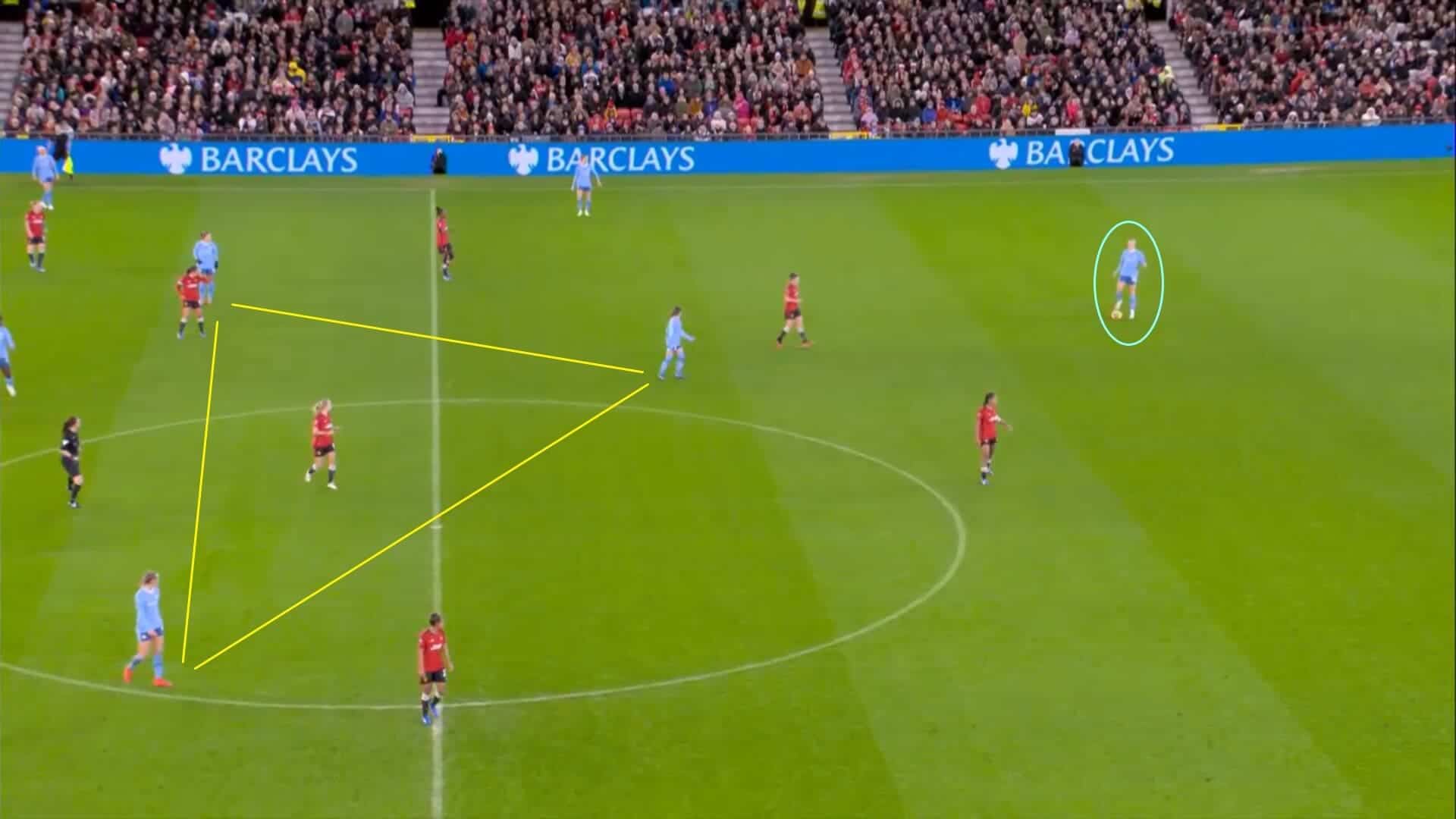
That desire to put on a coherent performance and one that delivered the right result was perhaps best shown in the midfield, with all three of Japan’s Yui Hasegawa, Sweden’s Filippa Angeldahl and the Netherlands’ Jill Roord working hard and co-ordinating with each other well in order to ensure that the team could both attack and defend with equal quality.
The way that they did that was not unusual, in that they set up in the same triangular shape as they do in almost every game and biasing it towards the attack, but it proved to be especially vital in this match that they played this way due to Manchester United Women setting up in a 4-2-3-1 formation and trying to limit the visitors’ ability to play too vertically whenever they had the ball.
However, with Angeldahl and Roord as wide as they are here and constantly staying this far apart from each other and from Hasegawa, who has offered herself to Australia defender Alanna Kennedy as a passing option here, it was clear that Manchester City were never intending to play in that way anyway, so that aspect of Manchester United’s tactics was easily negated as a result.
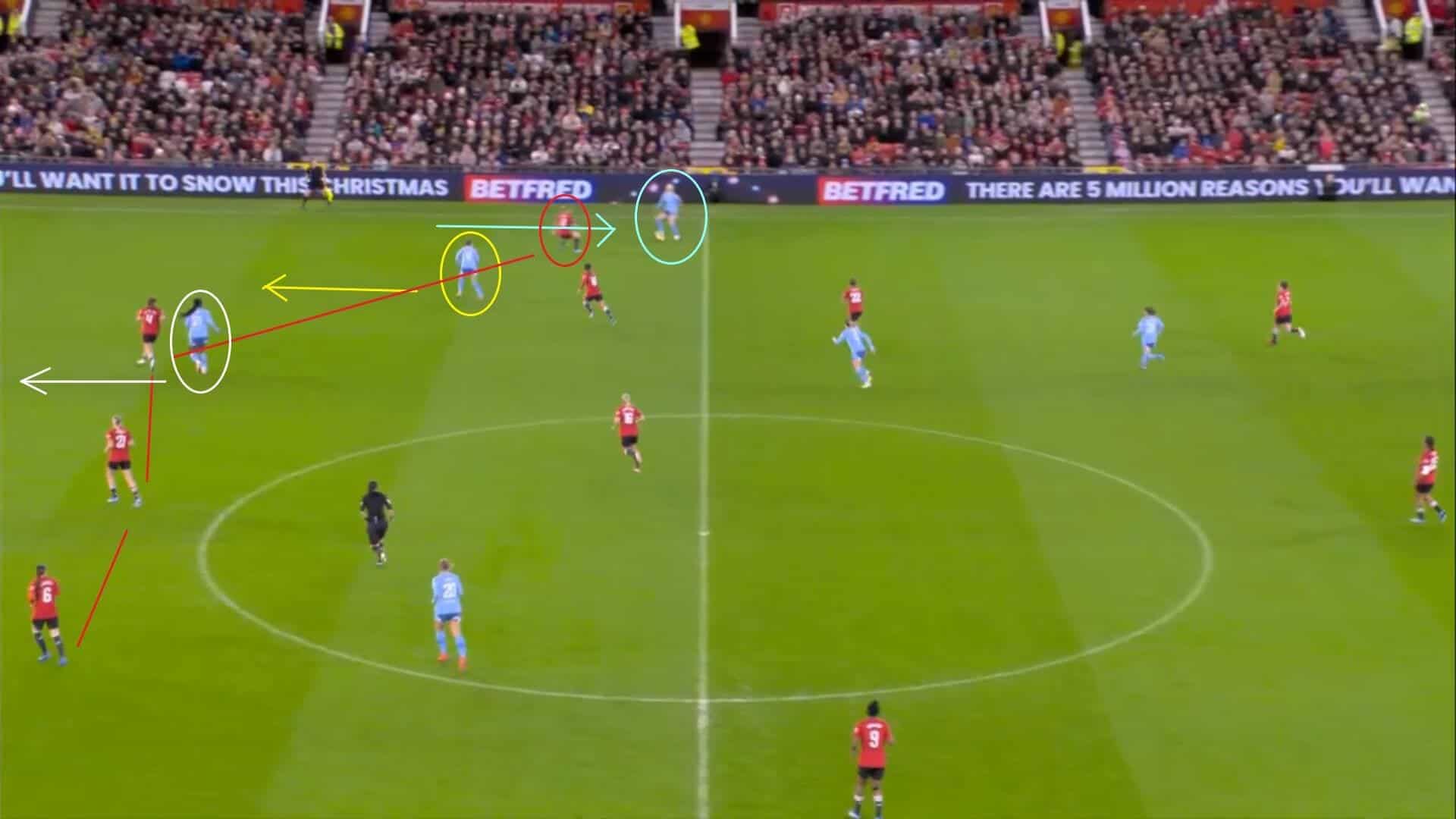
The other advantage of setting up in that shape was that it gave Manchester City effectively a five-player attacking line whenever they did have possession in advanced areas of the field, with Angeldahl and Roord slotting into the gaps between Chloe Kelly, Shaw and Hemp and giving Manchester United additional threats to deal with when inside their own third.
The positive that came from having those additional numbers was that the visitors were able to instigate positional rotations in different areas of the forward line, with them constantly trying to manipulate Manchester United into leaving spaces open and taking advantage of the fact that the home team did not have their usual back line and instead had players in roles that they were not as familiar with.
One of those who was caught out on several occasions was Galton, and it was likely due to her natural instinct to get higher up the pitch than she was here. In this case, her tendency to be too far away from the rest of the back line has been exploited well by Manchester City, with Kelly tempting her out of line by dropping back and Angeldahl simultaneously running through to occupy the space that has been left open.
The smoothness with which this rotation occurred demonstrated again how Manchester City’s success in this match was built on every player knowing their role and working together. It was a warning shot that Manchester United needed to heed if they were to contain their opponents with any success.
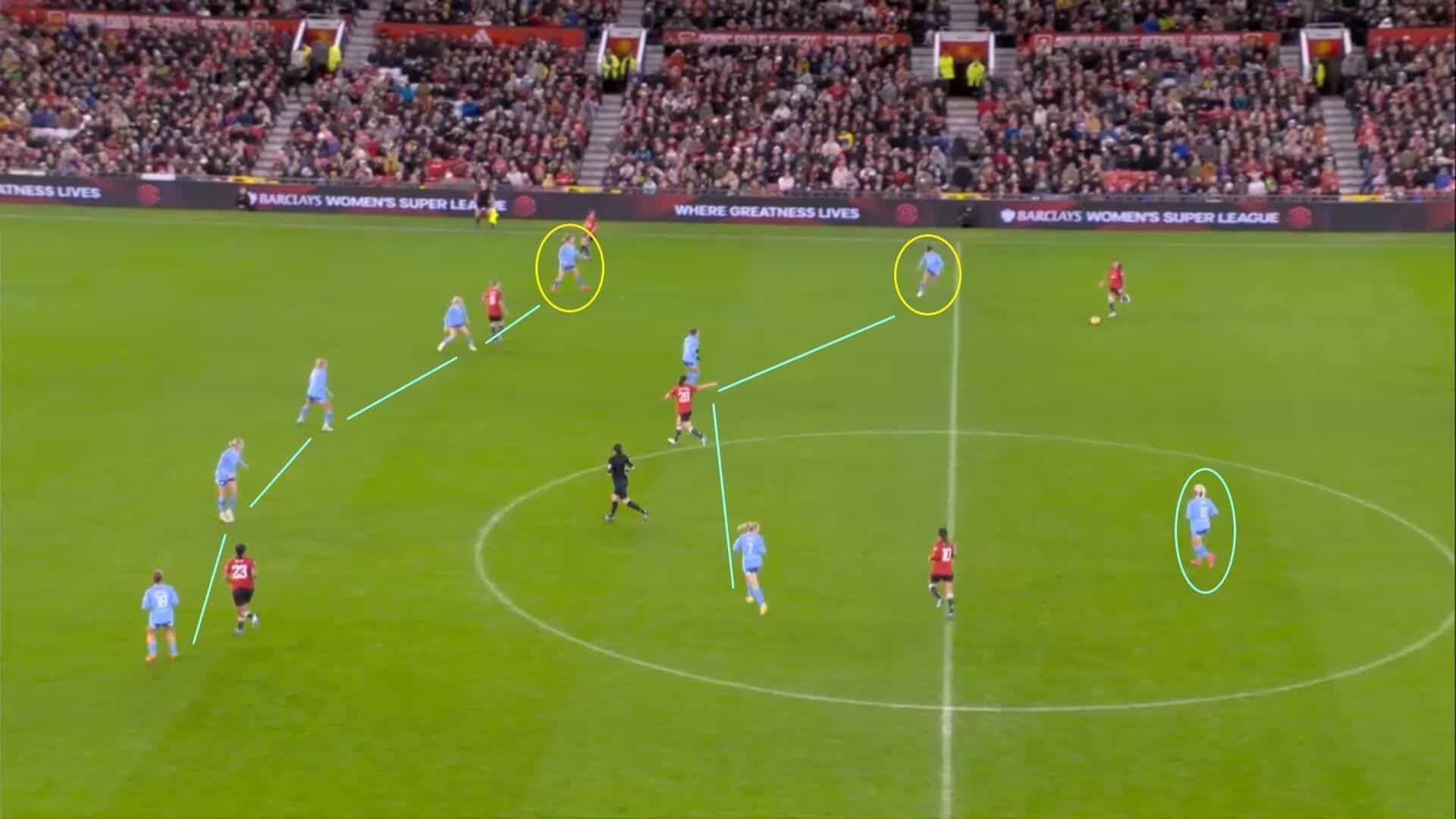
Even when they needed to sit back and focus on being robust out of possession, Manchester City continued to demonstrate their co-ordination and teamwork, with each player playing their part in making the team as tough to break down as possible. At this stage, they had been forced to change to a more defensive shape due to Aleixandri being sent off partway through the second half for two bookable offences, but there were still opportunities for players to move out of line and apply pressure and to try and force Manchester United’s hand.
In this case, it is Ouahabi who has done just that, with her moving into the midfield temporarily, but the critical detail is that Roord has read this and has now stepped back to replace her in the back line before both reverted to their usual positions a short time afterwards. It might only be a small point to make, but in the context of the match, little details like this demonstrated how efficient Manchester City were and why they took all three points from this contest.
Khadija Shaw’s role
Nevertheless, in any team effort, there are always one or two who stand out and without whom the result would not be the same, and that was no different here. In this case, Jamaica captain Shaw enjoyed that privilege, with her performance in this match providing a perfect demonstration of why she has become one of the league’s most feared strikers since switching from Bordeaux Féminines in 2021.
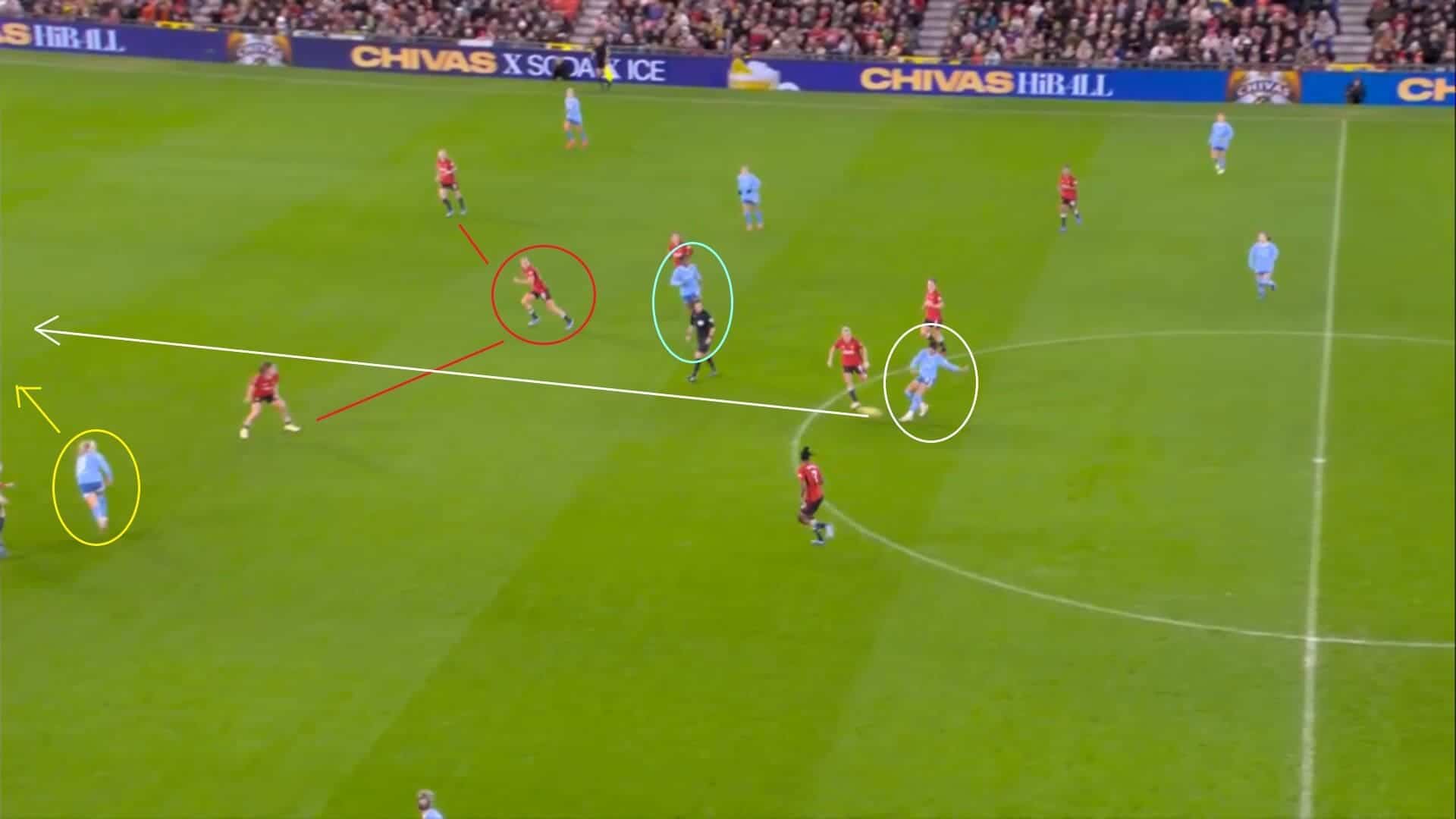
The key thing about Shaw is that she is not only a serial goalscorer but is often seen dropping back into deeper holes to create spaces for those around her, too, which is what some don’t notice as quickly.
However, it is something that she did a lot of at Bordeaux and which she has continued to do since moving to Manchester City, and it was once again in practice at Old Trafford and had the desired effect, with it playing a crucial part in aiding her team’s attempts to manipulate their opponents into leaving gaps open. In this case, Millie Turner fell into the trap, with the space opening up through the middle for Kelly to run through and use to her advantage, with Ouahabi threading a through ball into her path and allowing her to test Earps.
There is no doubt that the decision to swap Kelly and Hemp onto opposite wings did help here, with both making more runs into interior spaces, and that has proven to be the turning point in so many of Manchester City’s matches in recent times. However, it was Shaw’s initial movement that created the space, and that is what sometimes goes under the radar.

Other aspects of her individual performance stood out though, and one of those was her ability to constantly stay tight to Manchester United Women’s captain, Katie Zelem, whenever the ball was inside the home side’s third.
This was vital in Manchester City’s overall game plan, with the aim to press from the front and to force Manchester United to either pass long, where Kennedy and Greenwood could use their aerial prowess to win first balls, or to get caught in possession and to give them opportunities in promising areas. What Taylor’s side didn’t want to happen was for the ball to be passed into Zelem as soon as the press was instigated, with her normally one of the first players that Earps or the back line would look for when trying to progress up the field.
This proved to be hugely successful for the visiting side, with Zelem having some moments when she did get on the ball but being largely kept out of things in situations like this, and it meant here that Turner was forced to shift the ball sideways once Hemp moved towards her. Therefore, again, Shaw’s presence proved to be critical to Manchester City’s ability to stop their hosts from settling into their usual rhythm.
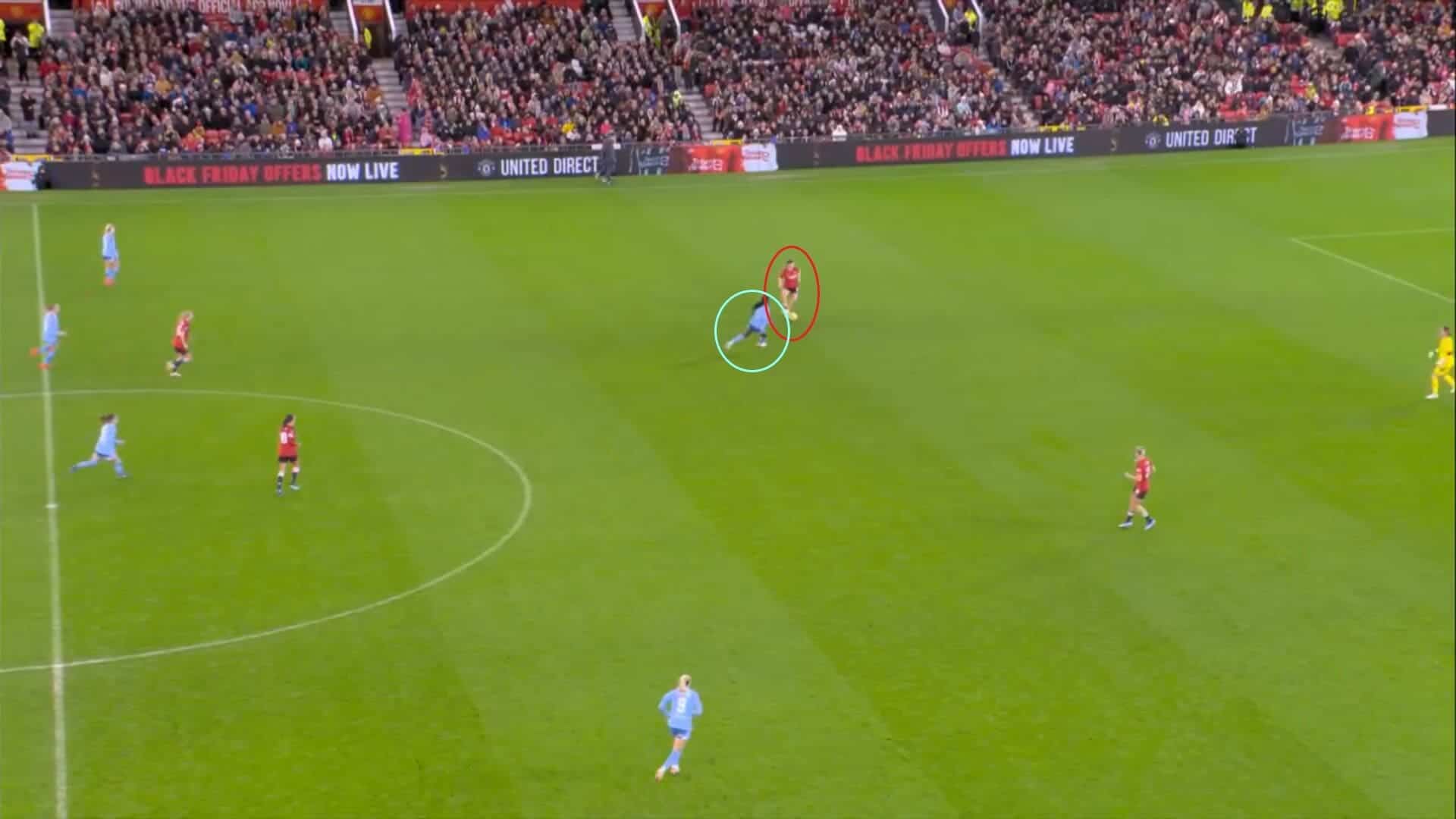
As the game went on, Shaw started to take a more proactive role in the press, with her looking to apply more pressure on Manchester United’s back line and to keep forcing them into making mistakes. This was largely due to Manchester United’s determination to keep playing out from the back and to use both Le Tissier and Turner whenever they could, meaning that Shaw knew what would happen every time they had the ball in these areas, but it allowed her to show another side to her game and one that is not seen as often.
Whenever she did get tight to individual opponents, she often forced them into making a pass prematurely, but Manchester United did usually manage to evade her clutches. However, as with other aspects of Manchester City’s play, they were warning shots of what could happen, and it was inevitable that one of those dangerous moments would eventually go against the hosts. In the second half, the worst did happen, with Le Tissier turning to pass back to Earps here but seeing Shaw press the England goalkeeper and turn the ball into the net.
What is important to note here is that Shaw was able to anticipate the pass and make Manchester United pay because it came down to the sharp change of direction that she made just as the initial pass arrived at Le Tissier’s feet. With Le Tissier telegraphing her intent, Shaw knew what would happen, and so, in effect, was already thinking about the next phase of the press, and, whilst it is another small detail to pick up on, it is something that proved to be vital in allowing this goal to come about.
Therefore, again, Manchester City played well as a team, but it would not have been as easy to secure the win without Shaw being on the pitch.
Manchester United Women’s problems
However, what most who were at Old Trafford or who watched the game at home will agree on is that, for all of Manchester City Women’s clever play, Manchester United Women were their own worst enemies at times, with them making it far too easy for their opponents to control the game and to secure yet another derby win.
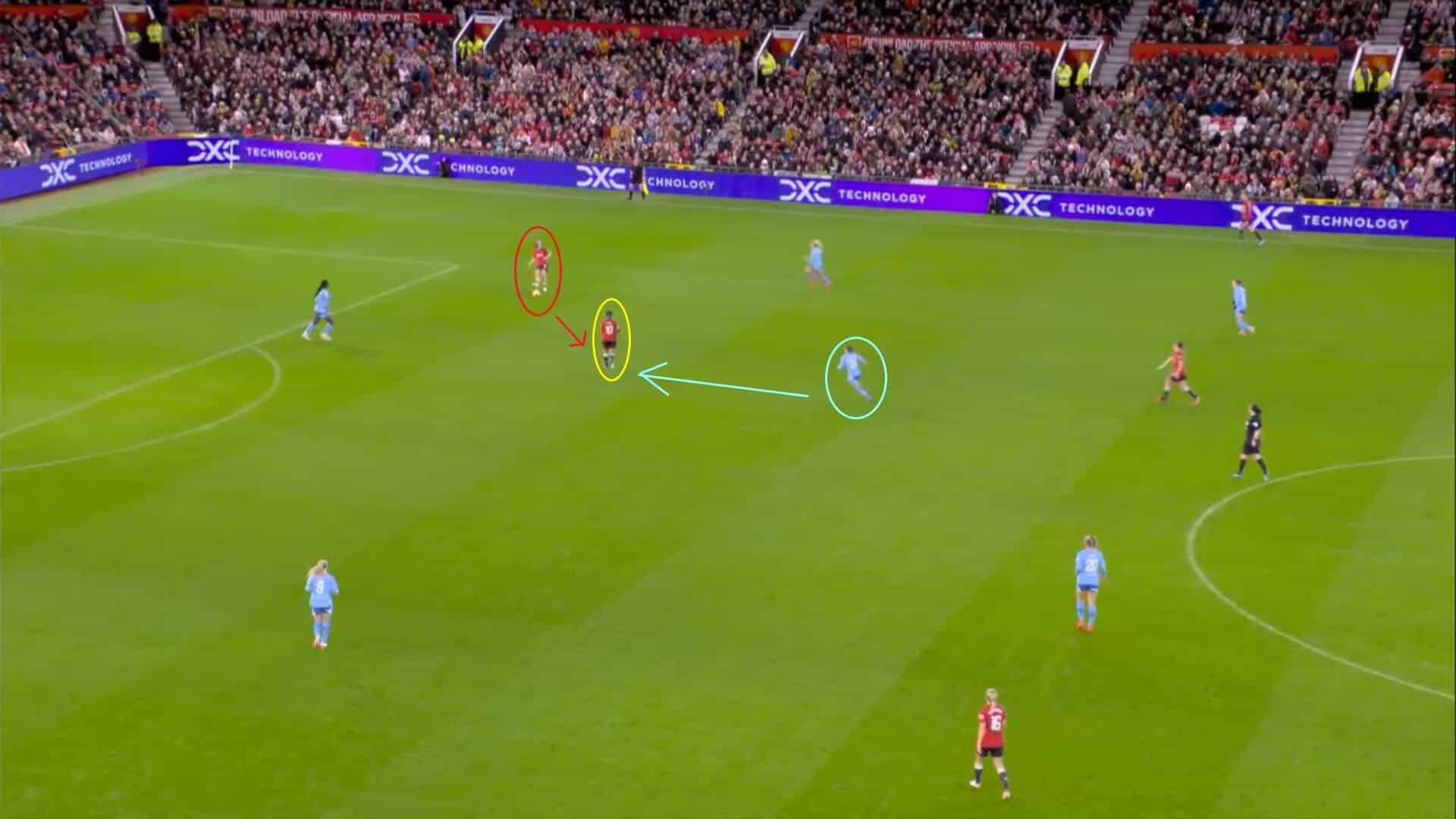
As mentioned, Manchester United constantly desired to play out from the back in this match, with a strong reliance on Le Tissier and Turner to find teammates around the field and launch attacks from inside their own third. However, this is not something that Skinner’s team do that often and their unease with this style of play was clear to see as the match went on, with them losing the ball countless times and making life increasingly difficult for themselves as the match went on.
The analysis has already shown one occasion when they paid for their persistence with something that wasn’t working, and this was another, with Le Tissier again in possession. This time trying to pass out to Zelem, who is free to receive the ball here. However, she has her back to the rest of the pitch and so is not able to see Hasegawa getting tight to her from behind, and that is what Le Tissier needs to be aware of here as she can see the press happening. Nevertheless, she still sends the ball towards her captain, and the result is that Manchester City win the ball back and score, with Shaw setting up Hemp to give the away side the lead.
There will be some debate as to who was at fault here because Le Tissier did need to read what was happening better, but the fact that it was seemingly a tactical decision to play this way and not to change when it wasn’t working will come down to Skinner and the way that he wanted to approach the game. It is a debate that will go on, but the simple fact is that, whilst it will go down as a sumptuous finish from Hemp, it was a goal that Manchester United could have so easily avoided.

It has also been pointed out that the home side were becoming very predictable whenever they had the ball, in that they never strayed from these tactics and weren’t showing any urgency to connect with those ahead of them, which was why Manchester City were able to press with so much success.
To demonstrate just how fruitful the press was for the visitors, this graphic shows how many times they won the ball in advanced positions and the effect that it had, with five of their regains leading to a shot on goal within five seconds (as happened here) whilst they won back possession just five seconds after losing it on 14 occasions.
All in all, what is clear to see is that Manchester City were playing at a much higher intensity than their hosts and showed a lot more desire to make things happen, and that was one key aspect that made the difference with regards to who won the match and who went home empty-handed.
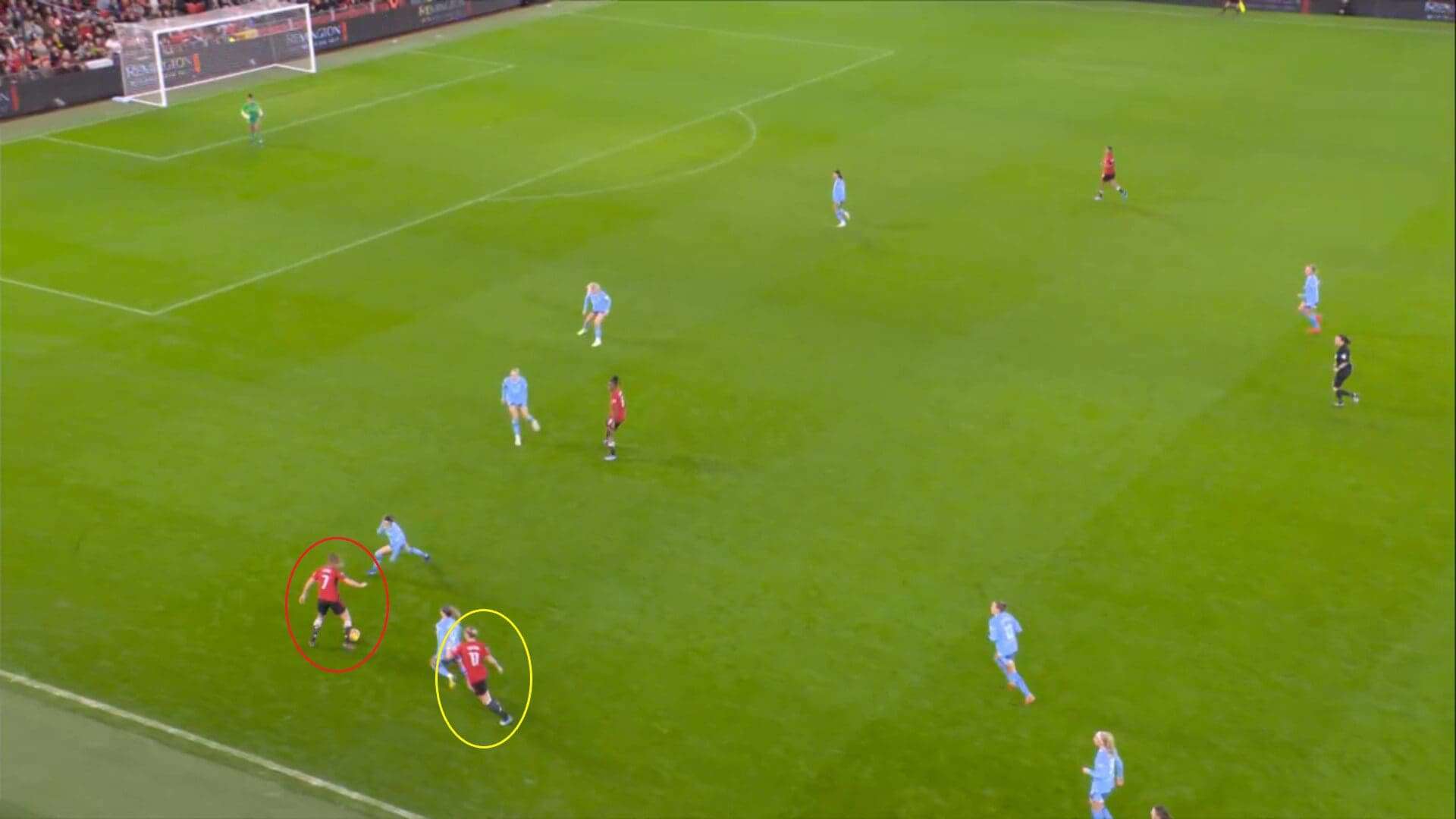
Going back to Manchester United’s tactics, the other thing that is worth noting is how they did make a personnel change at the break, with the ineffective Nikita Parris coming off after not really showing a true reflection of her recent good form in the first half and Riviere coming on to replace her.
The change also saw Blundell move back to her usual left-back role whilst Galton went to her usual wide attacking position, restoring Manchester United’s overall balance, and it felt as though Skinner had been trying something out before the break, perhaps trying to use Galton’s pace to control the wing and to allow Parris to cut inside and get into the areas where she has been so dangerous in recent weeks, and had realised that it hadn’t been working.
However, whilst it did give the players a little more confidence in what they were doing, it still didn’t provide them with any joy, and that was because they had retained their 4-2-3-1 shape instead of reverting to the 4-3-3 that has led to so much positivity for them in recent times, with it allowing Galton and whoever is on the other wing to push up the field and to offer passing options in the spaces behind opposing lines.
In this game, though, those runs weren’t happening due to those players being naturally behind the main striker, meaning that situations like this, where Ella Toone is looking to feed the ball into the space ahead of her but doesn’t have a teammate available to reach it, were common.
For Toone, this would have no doubt been incredibly frustrating, with her demonstrating during last week’s wins against Everton Women and West Ham (the former in the mid-week Continental Cup fixtures) that she can be used to her full effect when there are players ahead of her that she can link up with and pass to, and the fact that she didn’t have those in this game meant that she went back to having a largely quiet game. Again, it comes down to tactics, and it shows again how, whilst Manchester City were very good and deserved the win, Manchester United were so often the reason for their own struggles.
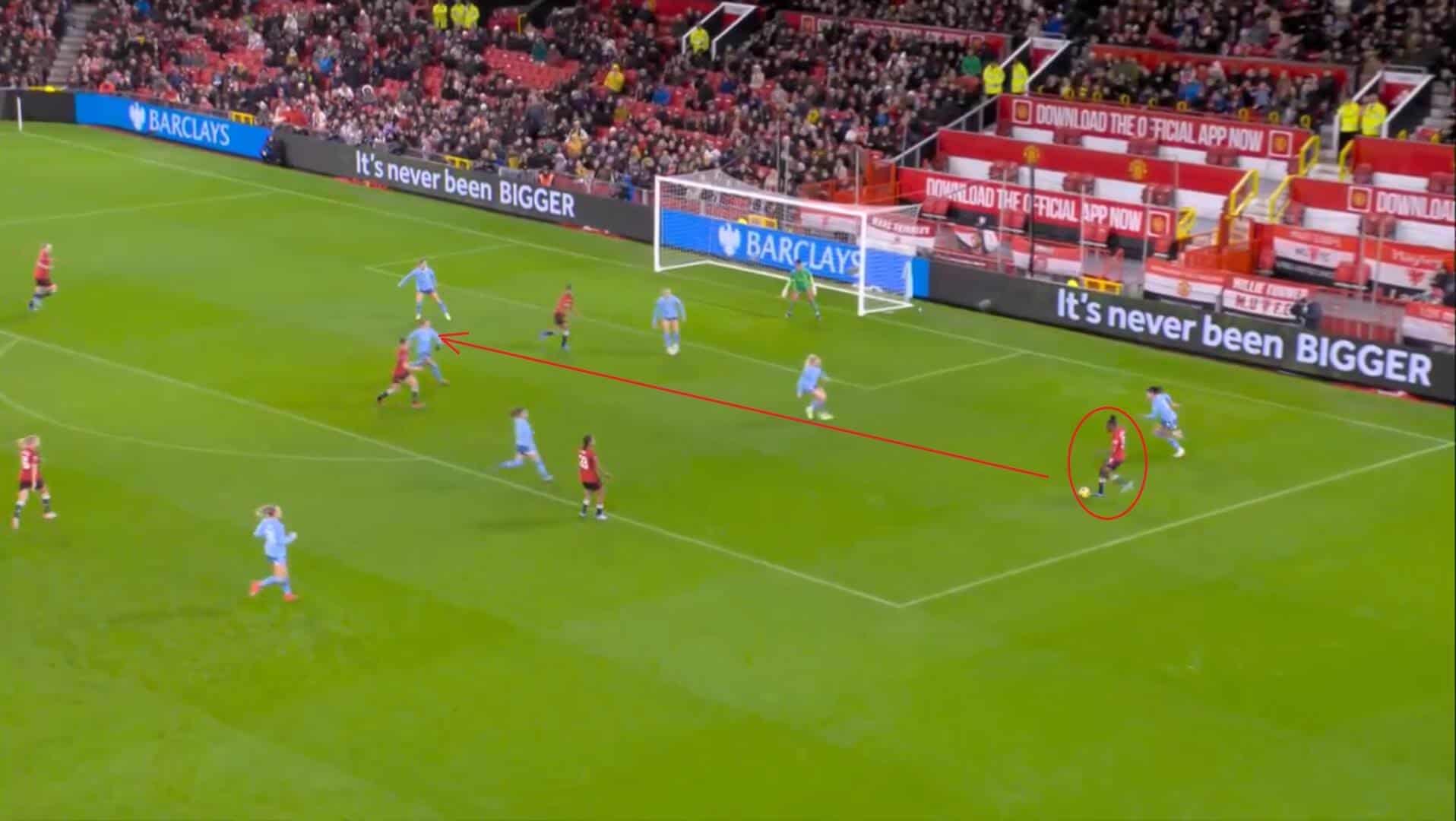
This is not to say that they didn’t test Manchester City’s back line, though, and they did have a period of play in the first half when they scored and then looked like building on it.
However, poor communication and co-ordination continually let them down, with Malard in possession here and looking for a teammate in the middle to get on the end of her cross, but her pass simply dissected the three Manchester United players nearest it, and it was cleared from danger by Aleixandri instead.
It was noted in match commentary that Malard was looking at her teammates following this particular pass and was asking why none of them made an effort to meet the ball and that those in the middle were asking why the France forward didn’t target one of them when sending the ball in, and that summed up their attacking issues in many ways. If it wasn’t a lack of communication, it was a player not timing their run correctly or the ball not being looked after well enough, and so even though Manchester United did have chances and were in the ascendency at stages of the game, they were never able to capitalise on those moments and were continually let down by individual and whole team mistakes.
Conclusion
In conclusion, this tactical analysis has looked in detail at the weekend’s Manchester derby in the WSL, highlighting the reasons that Manchester City Women went home with all three points and a lot of positivity and Manchester United Women ended up with another defeat recorded against their rivals.
There are lots of tactical reasons that this analysis has gone into, but the simple fact is that Manchester City had a better game plan and didn’t overcomplicate matters once the match had kicked off, with them playing to their strengths and never trying to do things that they knew they weren’t capable of, whilst Manchester United were clearly experimenting a little and ended up being the cause of their own issues as a result.
It was interesting to hear Skinner talk afterwards about the gap in the table between his team and leaders Chelsea, which now stands at seven points following seven weeks of action, and how he knows his team will have to deal with that as the season goes on, with two games against Emma Hayes’ outfit still to come.
If they are to bridge it, then they will need to find ways of winning matches of this magnitude, because, whilst they succeeded in pushing Chelsea all the way last season, they will not manage to make the final step and end the Kingsmeadow club’s reign of dominance without developing a way of defeating others in the league’s top four.





Comments